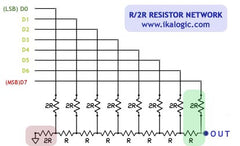Although many users may consider pulse-width modulation a form of analogue output with their Arduino (and when controlling the brightness of an LED it is a simple solution), it is not DAC at all. However even though we don't have one as standard with our Arduino boards, a form of DAC can be created with a little time by making our own with what is called the "R/2R" resistor network. This allows you to create a voltage output that is relative to a number on the Arduino. In summary, it consists of eight resistors each connected to a digital output, which are then meshed in with another eight resistors, for example:

This type of circuit can be useful to create forms of audio or other variable signal outputs. To learn more about digital to analogue conversion, and making your own using an Arduino - visit this useful tutorial by Ikalogic. And we're on twitter and Google+, so follow us for news and product updates as well.

When making your own DAC, you'll need a protoshield to mount the external circuitry. In doing so, consider our range of ProtoShields. From the tiny LeoStick to the Mega range, we offer a complete range for you to work with.










